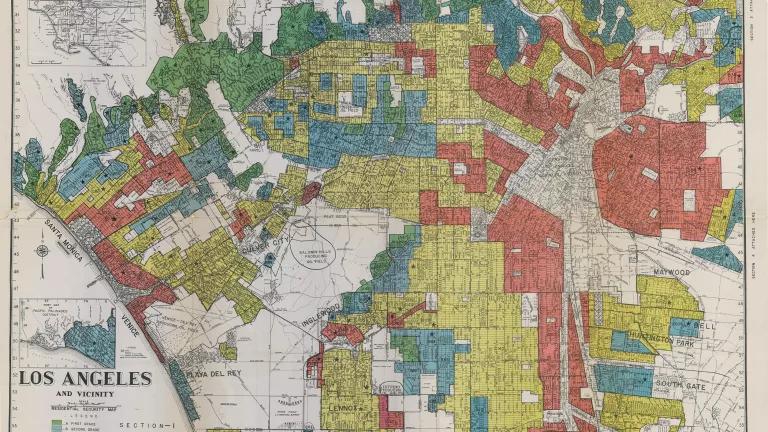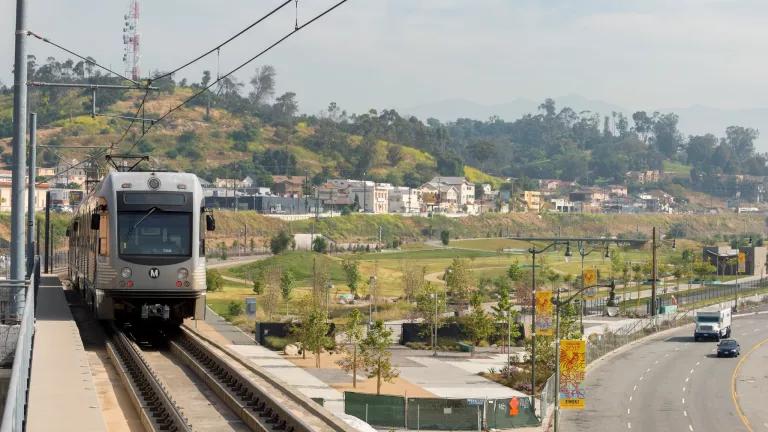Groundbreaking California Law Will Create Innovative Pathways for Social Housing
The visionary social housing study bill that identifies pathways to 1.4 million stable, affordable homes for California’s most vulnerable residents just became law.

The 1938 Home Owners’ Loan Corporation map of Los Angeles. The map shows the practice of redlining based on race and class, which deprived certain neighborhoods of essential resources.
The HOLC
Rae Huang is a senior organizer at Housing Now!, a broad and diverse coalition combating the housing crisis across California and a cosponsor of Senate Bill 555.
By leveraging expertise and support from state agencies, the Stable Affordable Housing Act of 2023 (SB 555) requires California to examine how to marshal public, nonprofit, and cooperative housing production and acquisition to establish permanent affordability for the state’s disadvantaged communities. The new law requires the Department of Housing and Community Development to complete the study by 2027.
The housing and climate crises call on all of us, especially our leaders, to act and address social and racial inequality where life begins—in the home. California must address these inequities by developing strategies that will provide opportunities for vulnerable climate-challenged populations to access affordable, healthy, safe, and sustainable housing. Transit-oriented development strategies to increase housing and reduce carbon emissions will fail if working-class Californians—who are most dependent on transit—cannot afford to live anywhere near it.
The legislation, recently signed by Governor Gavin Newsom and authored by State Senator Aisha Wahab, was developed and led by more than 150 organizations convened by Housing Now!, a statewide coalition that includes NRDC.
What is social housing?
Social housing encompasses a range of models rooted in the idea that housing should empower communities, not create obscene profits for corporate landlords. It works by providing city-owned land or leasing existing buildings to community-led organizations to develop and manage housing directly—exclusively for the benefit of local renters and residents in need of stable homes.
Run by public agencies, nonprofits, or tenants themselves, social housing is designed so that rents stay affordable forever, not exceeding 30 percent of income, while also providing tenants with the training and authority to manage their own buildings.
The U.S. Department of Housing and Urban Development (HUD) considers housing to be affordable when a household spends 30 percent or less of its income on housing costs. Yet, in California, the Legislative Analyst’s Office reports that Californians contribute a larger proportion of their income toward rent than any other state in the nation; in fact, as much as 55 percent of renters in California are cost burdened, compared to 50 percent in the United States.
Furthermore, 2.5 million low-income Californians are housing burdened, which means they contribute more than 30 percent of their income toward housing. Add rising inflation and housing costs to this equation, and you have increased levels of poverty that have risen from 11 percent to 15 percent, further elevating existing inequities.
Social housing can also provide tenants with a pathway to homeownership by establishing payments they can afford over a reasonable period of time. It’s an option of earning equity in property that many residents have never had due to disenfranchisement, discrimination, and redlining.
What is the connection between the climate crisis and communities of color?
Extreme heat, hurricanes, floods, wildfires, and other climate challenges disproportionately affect and devastate communities of color that are already disadvantaged by generations of racist and classist housing policies, displacement, and policing. Simply put, climate change exacerbates existing inequities.
A recent report on the demographics of eviction filings found that, despite comprising only 18.6 percent of all renters, Black Americans account for 51.1 percent of those affected by eviction filings and 43.4 percent of those who are actually evicted. Roughly one in five Black Americans living in a renter household is threatened with eviction annually, while 1 in 10 is evicted.
Additionally, a 2020 study by the state’s Legislative Analyst’s Office found that communities impacted by a discriminatory practice known as redlining were more likely “to experience hotter temperatures and more flood risk than other areas. In addition, these areas often have fewer parks and trees and more paved surfaces.”
Redlining is a historic exclusionary, race-based tactic perpetuated by the real estate industry—and supported by the government—to bar Black families from the real estate market through racial covenants, lowering the value of land owned by Black families, and directing Black families to move into color-coded, segregated, lower-valued areas; hence, the term redlining (see the map above). As a result, redlined neighborhoods where Black families owned properties were historically underfunded, less resourced, and neglected.
For these historically under-resourced neighborhoods and communities, the climate crisis deepens the existing inequities of the housing crisis, which calls for the urgent need to advance climate-resilient social housing solutions for communities that are most at risk.
Housing is a human right
NRDC is proud to join the dynamic movement of tenant unions, labor organizations, and health, housing, and environmental justice advocates that came together to urge state legislators and the governor to prioritize housing as a fundamental human right through the passage of SB 555.
At a time when California’s housing affordability is at an absolute low, social housing as a solution is desperately needed—and most urgently for communities at risk of homelessness, who struggle to maintain a roof over their heads every day.
California is again leading the way and addressing the many intersecting crises at the most pressing times. The Stable Affordable Housing Act will get us to a future of sustainability and affordability, and a more equitable society. This is a first step toward developing the much-needed strategies that will provide a road map home for all Californians.



